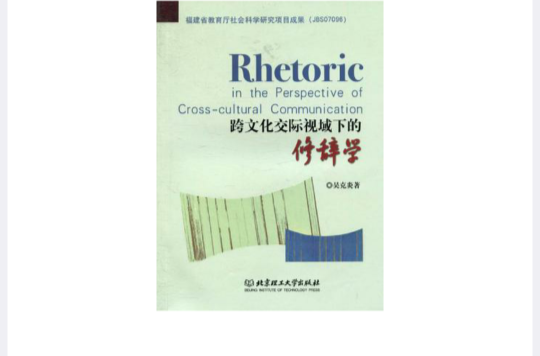《跨文化交際視域下的修辭學》是2010年北京理工大學出版社出版的圖書,作者是吳克炎。
基本介紹
- 書名:跨文化交際視域下的修辭學
- 頁數:234頁
- 裝幀:平裝
- 開本:16
圖書信息,作者簡介,內容簡介,目錄,
圖書信息
出版社: 北京理工大學出版社; 第1版 (2010年7月1日)
平裝: 234頁
正文語種: 簡體中文, 英語
開本: 16
ISBN: 9787564032333, 7564032332
條形碼: 9787564032333
尺寸: 22.6 x 16.8 x 1.2 cm
重量: 358 g
作者簡介
吳克炎,1970年生於福建省龍巖市。1994年畢業於漳州師範學院英語系並留校任教至今,現任漳州師範學院外語系副教授。2003年起擔任外語系套用教研室主任。2004年獲福建師範大學文學碩士學位。2009-2010年在北京大學擔任教育部高等學校青年骨幹教師國內訪問學者。
主要從事英漢修辭學、翻譯理論與實踐研究,主持完成福建省教育廳課題2項、漳州師範學院課題2項。在《中國大學教學》《齊齊哈爾大學學報》等刊物上發表學術論文近30篇。翻譯出版漢英對照的《汝窯遺珍》。
內容簡介
英語修辭和漢語修辭是兩個不同的概念,如何在兩者之間尋求一個結合點就成了一個重要的研究課題。《跨文化交際視域下的修辭學》以跨文化交際為視角,以修辭效果為契合點,從修辭定義到論證過程都貫穿將兩者有機結合這一思想。全書在充分對比研究英漢修辭、提供修辭基本研究架構的基礎上,十分注重修辭的套用研究。由於雙語轉換過程中的句式語詞選擇以及文化意象轉換大多數都涉及修辭現象,深入分析修辭效果遺失與保持的根本原因,能夠促進對英語寫作、英漢互譯的深層理解,並且做到知其然而且知其所以然,特別有助於指導如何處理翻譯過程中“形式與內容”之間的矛盾。此外,《跨文化交際視域下的修辭學》倡導“快樂修辭”理念,其例證有別於傳統修辭著作,大部分是源自於生活的實例,與現實生活更加緊密結合;每個實例都有針對性的分析,更具闡釋力,更具吸引力,更具生命力。全書用英語寫作,適合具有一定英語基礎的學習者學習,也適合作為修辭學教材使用。
目錄
序(辜正坤)
Foreword
Chapter One Introduction
Ⅰ. Definitions of rhetoric
A. Denotation of rhetoric
B. Connotation of rhetoric
C. Six basic features of good expressions
Ⅱ. Functions of rhetoric
A. Being more appropriate
B. Being more attractive
C. Being more forcible
D. Being more humorous
Ⅲ. Classification of rhetoric
Ⅳ. Rhetoric in the perspective of cross-cultural communication
Chapter Two Comparison and Contrast Between English and Chinese Rhetoric
Ⅰ. Language and rhetoric
Ⅱ. Language, rhetoric and thought
Ⅲ. English and Chinese rhetoric
A. Passive rhetorical techniques
B. Active rhetorical techniques
Chapter Three The Faculty of Rhetorical Invention
Ⅰ. The origin of rhetorical invention
Ⅱ. The essence of rhetorical invention
Ⅲ. The cases of rhetorical invention
A. Controversial topic
B. Non-controversial topic
Chapter Four Passive Rhetorical Techniques
Section One Contextual Choice of Words and Expressions
Ⅰ. Being fit for a certain situation
Ⅱ. Being appropriate stylistically
A. English examples
B. Chinese examples
Ⅲ. Being idiomatic
A. Using idioms
B. Using words in their figurative sense in English vs.
words with vague reference or enigmatic folk similes in Chinese
Section Two Textual Choice of Words, Expressions and Sentence Structures
Part 1 English Prominent Feature: Elegant Variation
Ⅰ. The solid basis
A. Vocabulary
B. Grammar
Ⅱ. Various forms of variation
A. Forms in diction
B. Forms in sentence structures
Part 2 Chinese Prominent Features
Ⅰ. Sentence structure: elegance of balance
Ⅱ. Elegance of artistic conception
Section Three Application
Part 1 Application of the English Prominent Features
Ⅰ. Elegant variation
A. Forms in diction
B. Forms in sentence structures
Ⅱ. English words in their figurative sense
Part 2 Application of the Chinese Prominent Features
Ⅰ. Chinese balanced structures
Ⅱ. Periodic sentences
Ⅲ. Chinese words with vague reference
Ⅳ. Xiehouyu
Part 3 Application of English/Chinese Idiomaticness
Chapter Five Active Rhetorical Techniques
Section One Devices Whose Rhetorical Effects Can Generally Be Retained
A. Apostrophe
B. Asyndeton, poly-syndeton
C. Climax, anticlimax
D. Contrast
E. Epanorthosis
F. Hyperbole, understatement
G. Paradox, oxymoron
H. Parallelism
Ⅰ. Personification, Niwu
J. Rhetorical question
Section Two Devices Whose Rhetorical Effects Can Partly Be Retained
Ⅰ. On the psychological basis
A. Allusion
B. Metonymy, simile, metaphor
C. Parody
D. Symbol
E. Synaesthesia
F. Transferred epithet
G. Zeugma, syllepsis
Ⅱ. On the aesthetical basis
H. Anadiplosis
Ⅰ. Antithesis
J. Euphemism
K. Irony, sarcasm, innuendo
L. Malapropism
M. Onomatopoeia
N. Palindrome, antimetabole
O.Pun
Ⅲ. On the emphatic basis
P. Anastrophe
Q. Repetition
Section Three Devices Whose Rhetorical Effects Cannot in General Be Retained
Ⅰ. Figure of sound
A. End rhyme
B. Internal rhyme
C. Assonance
D. Alliteration
E. Half rhyme
F. Consonance
G. Paregrnenon
Ⅱ. Other figures of speech
A. Cangci
B. Chaizi
C. Xiangqian
D. Qianci
Bilingual Glossary of Terms
Bibliography
後記

